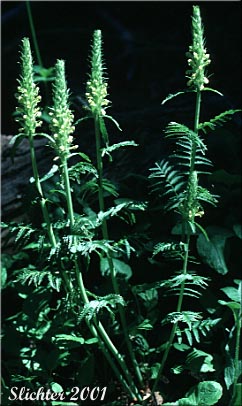 Photo
at right of bracted lousewort from Paddy Go Easy Pass, Alpine Lakes Wilderness
of the central Washington Cascades.........July 24, 1996.
Photo
at right of bracted lousewort from Paddy Go Easy Pass, Alpine Lakes Wilderness
of the central Washington Cascades.........July 24, 1996.
Bracted lousewort is a fairly attractive and distinct perennial wildflower with erect, unbranched stems from 60 to 90 cm high. The herbage is smooth or glabrous below the inflorescence although some varieties may have hairs or glands within the inflorescence. The leaves are short-petiolate or sessile and alternate along the stem. The pinnately compound leaves are larger as basal leaves and become reduced and bract-like near the inflorescence. Individual leaflets are linear-oblong to lanceolate and range form 1-7 cm in length. The leaflets also range from deeply toothed to divided.
The inflorescence is a dense bract-like spike with yellow, white, or reddish flowers individually fused into a tube with an upper hooded lobe and a lower lip of three smaller lobes. The corolla ranges from 13-21 mm in length. The sepals are fused with 5 teeth. The 4 stamens are fused to the petal tube.
Bracted lousewort may be found in subalpine woods and in moist slopes and meadows in the mountains.
Bracted lousewort may be found from British Columbia south to northern California through the Cascades, and eastward to Alberta and south through the Rocky Mts. to Colorado.
In the Columbia River Gorge it is found between the elevations of 3300'-4400' in and about the Columbia Wilderness.